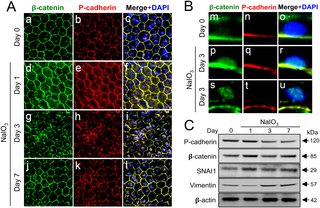PLOS ONE ( IF 3.7 ) Pub Date : 2018-01-16 , DOI: 10.1371/journal.pone.0191279 Xue Yang , Jin-Yong Chung , Usha Rai , Noriko Esumi

|
The retinal pigment epithelium (RPE) supports the health and function of retinal photoreceptors and is essential for normal vision. RPE cells are post-mitotic, terminally differentiated, and polarized epithelial cells. In pathological conditions, however, they lose their epithelial integrity, become dysfunctional, even dedifferentiate, and ultimately die. The integrity of epithelial cells is maintained, in part, by adherens junctions, which are composed of cadherin homodimers and p120-, β-, and α-catenins linking to actin filaments. While E-cadherin is the major cadherin for forming the epithelial phenotype in most epithelial cell types, it has been reported that cadherin expression in RPE cells is different from other epithelial cells based on results with cultured RPE cells. In this study, we revisited the expression of cadherins in the RPE to clarify their relative contribution by measuring the absolute quantity of cDNAs produced from mRNAs of three classical cadherins (E-, N-, and P-cadherins) in the RPE in vivo. We found that P-cadherin (CDH3) is highly dominant in both mouse and human RPE in situ. The degree of dominance of P-cadherin is surprisingly large, with mouse Cdh3 and human CDH3 accounting for 82–85% and 92–93% of the total of the three cadherin mRNAs, respectively. We confirmed the expression of P-cadherin protein at the cell-cell border of mouse RPE in situ by immunofluorescence. Furthermore, we found that oxidative stress induces dissociation of P-cadherin and β-catenin from the cell membrane and subsequent translocation of β-catenin into the nucleus, resulting in activation of the canonical Wnt/β-catenin pathway. This is the first report of absolute comparison of the expression of three cadherins in the RPE, and the results suggest that the physiological role of P-cadherin in the RPE needs to be reevaluated.
中文翻译:

视网膜色素上皮(RPE)中的钙黏着蛋白再访:P-钙黏着蛋白是人和小鼠RPE体内表达的高度主导的钙黏着蛋白
视网膜色素上皮(RPE)支持视网膜感光器的健康和功能,对于正常视力至关重要。RPE细胞是有丝分裂后,终末分化和极化的上皮细胞。但是,在病理情况下,它们会失去上皮的完整性,变得功能失调,甚至脱分化并最终死亡。上皮细胞的完整性部分通过粘附连接来维持,该粘附连接由钙粘蛋白同二聚体和连接至肌动蛋白丝的p120-,β-和α-catenins组成。尽管在大多数上皮细胞类型中,E-钙粘着蛋白是形成上皮表型的主要钙粘着蛋白,但根据培养的RPE细胞的结果,据报道RPE细胞中的钙粘着蛋白表达不同于其他上皮细胞。在这项研究中,体内。我们发现P-cadherin(CDH3)在小鼠和人类原位RPE中都占主导地位。P-钙粘着蛋白的显着程度出乎意料的大,小鼠Cdh3和人CDH3分别占三个钙粘着蛋白mRNA总数的82–85%和92–93%。我们证实P-cadherin蛋白在小鼠RPE的细胞边界处原位表达通过免疫荧光。此外,我们发现氧化应激会诱导P-钙粘蛋白和β-连环蛋白从细胞膜解离,并随后将β-连环蛋白转移到细胞核中,从而激活经典Wnt /β-连环蛋白途径。这是对RPE中三种钙粘蛋白表达的绝对比较的首次报道,结果表明,P-钙粘蛋白在RPE中的生理作用需要重新评估。



























 京公网安备 11010802027423号
京公网安备 11010802027423号